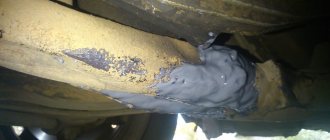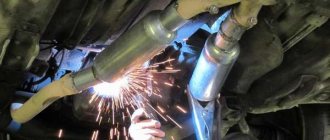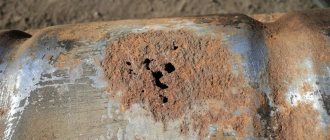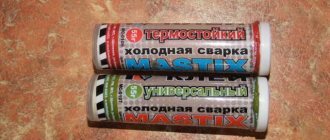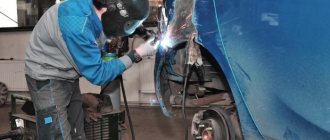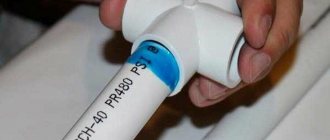The muffler is an element of the vehicle that is most susceptible to mechanical damage, temperature changes and exposure to aggressive chemicals. The most common cause of damage is corrosion. Elimination of defects using traditional welding operations is fraught with burns or deformation from overheating. Cold welding for the muffler is optimal. This is an affordable method that allows you to easily repair damage. It is difficult for a beginner in these operations to make a decision on his own, and he wonders whether it is possible to cold weld a muffler. Of course, it is always better to at least get professional advice. This material is manufactured in the following versions:
- for metal;
- for auto;
- universal.
Looking for a reason
What affects the premature failure of muffler pipes:
- The temperature regime of the exhaust gases at the entrance to the receiving pipes of the manifold, called pants by car owners, is close to 10,000 C;
- Poor quality fuel and consequences: products of incomplete combustion;
- Moisture condensation;
- External mechanical damage.
An inspection with the engine off on an overpass usually gives immediate results. Deviations in color, traces of drips are a signal for a scrupulous search for the hole. Dismantling and thorough inspection of the surface of the muffler and pipes will make it possible to prevent catastrophic destruction of the integrity of the metal and corrugations.
If the area of the hole does not exceed the size of a pin head, we can safely undertake the repair on our own . A hole larger than a coin or a longitudinal crack will require more attention.
But there are no barriers for a craftsman. And we can cope with this problem by strengthening cold welding with a substrate. A hole in the exhaust manifold pipe requires immediate action while it is small. We missed it - we’ll still manage without a car service.
Where and how is muffler sealant used?
In most cases, the following parts are processed using this tool:
- Elements of a new exhaust system. In particular, the joints of the internal annular surfaces of parts, pipes, flanges. In this case, the thickness of the sealant layer can be different, up to 5 mm.
- Sealing elements of the existing exhaust system. Likewise, the joints where exhaust gases leak, flange connections, etc.
- When repairing a muffler. Here it is used for three purposes. The first is when a crack/cracks appear on the muffler body. The second is that if a metal patch is used to repair the muffler, then in addition to the fastening elements, it must also be mounted using a sealant. Third, in a similar situation, it is necessary to treat the self-tapping screws (or other fasteners, such as rivets) that are used to install the patch on the muffler body with sealant.
Tips for using heat resistant adhesive to repair a muffler:
- Before applying sealant to the surface to be treated, it must be thoroughly cleaned of debris, rust, and moisture. Ideally, you should also degrease (it is better to clarify this nuance in the instructions, since not all sealants are resistant to oil).
- The sealant must be applied in an even layer, but without excess. The exhaust system paste squeezed out from under the folded surfaces must be carefully removed (or spread on the side surfaces to ensure greater tightness).
- Muffler sealant typically takes a minimum of one to three hours to cure at normal temperatures. The exact information is written in the instructions.
- The sealant can only be used as a temporary measure or to repair minor damage to exhaust system components. In case of significant damage (large rotten holes), the element must be replaced.
An excellent use of sealant is prevention and assembly of elements of a new system.
Application
Adhesive sealants or cold welding based on epoxy resins are suitable for eliminating gas tank leaks and restoring the radiator . There is also a solution for a hot muffler that is not afraid of temperature aggression.
Species composition:
- one-component formulations, ready for use after kneading;
- two-component liquid formulations;
- two-component plasticine-like;
- high temperature compounds.
Important! heat-resistant adhesives can withstand heat loads of 200–14000 C; increasing the temperature during the polymerization period strengthens the mixture.
Adhesive compounds recommended for restoring the exhaust system tolerate vibration, shock loads and stress without consequences. They have diffusion adhesion to steel and cast iron.
Precautionary measures due to the toxicity of the compounds:
- Natural ventilation of the room;
- Work should be carried out with rubber gloves;
- Mix the components in a non-metallic non-food container;
- In case of contact with skin, wash off with soap.
What are the criteria for choosing a muffler sealant?
Despite all the variety of car muffler sealants available in stores, you shouldn’t buy the first one you see! First you need to carefully read its description, and only then make a purchasing decision. So, when choosing a sealant, you need to pay attention to the following factors.
Temperature operating range
This is one of the most important indicators. Theoretically, the higher the maximum permissible operating temperature, the better. This means that the sealant, even with prolonged use and high temperatures, will not lose its properties for a long time. However, in reality this is not entirely true. Many manufacturers deliberately mislead consumers by indicating the maximum permissible temperature that the sealant can cope with only for a short time. Naturally, this value will be higher. Therefore, you need to look not only at the maximum permissible temperature value, but also at the time that the sealant is designed at this temperature.
State of aggregation
In particular, heat-resistant muffler and exhaust pipe sealants are divided into silicone and ceramic.
silicone sealant remains slightly mobile, and does not lose its properties during vibration or small shifts of the processed parts. These are used on gaskets when connecting exhaust system elements.
Ceramic sealants (also called pastes or cements) become completely immobile (stone-like) after hardening. This is why it is used to cover up cracks or rusted holes. Accordingly, when vibrations occur, they can crack.
There are always small shifts and vibrations between the elements of a car's exhaust system. Moreover, even when driving, the car constantly vibrates on its own. Accordingly, it is advisable to use a silicone-based muffler sealant paste. Cement for a muffler is only suitable for directly processing the body of the muffler itself.
Sealant type
Sealing materials used to repair exhaust system elements are divided into several types, differing in their performance characteristics.
- Exhaust system repair adhesive . Such compounds are intended for sealing small holes and/or cracks in the exhaust pipe and other parts. As a rule, it is created on the basis of glass fiber and additional additives. It differs in that it hardens quickly (in about 10 minutes). It is resistant to thermal loads, but can also crack under strong mechanical loads.
- Mounting paste . Typically used for machining flange and hose connections. As a rule, it is used when installing new parts or when repairing and installing repaired ones. When exposed to high temperatures, it hardens quickly and retains its properties for a long time.
- Muffler sealant . This is one of the most common options. It is made on the basis of silicone with thermal additives. Can be used both as a preventive and repair agent. Silicone sealant can be used directly in the muffler, pipes, resonator, exhaust manifold. Doesn't freeze right away.
- Cement for muffler . These compounds have very high hardness and can withstand the highest temperatures. However, they can be used to repair only fixed parts - muffler housings, resonator, as well as for processing joints. Cement dries very quickly when exposed to high temperatures.
Choice
We recommend the brand of cold welding for the car muffler DONE DEAL thermal steel 1400 C. The digital designation indicates the permissible temperature. Components: sodium silicate, synthetic fibers. The strength of the connection is given by the metal filler .
Titanium will withstand heating up to 3000 C without damage. It is supplied in 2 types: with a kneading rod and separately - hardener and glue in different jars. According to reviews, the advantages prevail. Worth keeping in stock.
Abro Steel is inferior in temperature indicators. The collector will not withstand thermal shock. It will work on the muffler. It can withstand dynamic loads, but with difficulty. Not afraid of water and aggressive liquids. Do not heat until complete polymerization.
The initial setting of cold welding takes 5–20 minutes . The exact numbers are in the instructions. Corrections to the form and filling are allowed until the drying period of the surface layer has expired. After 24 hours, the sealant can be machined.
Removing excess or damaged sealant with solvents is not always effective. An alternative is mechanical cutting with a chisel, filing with a file, or with a power tool.
Strength is an undoubted advantage: cold welding for a car muffler can withstand machining and drilling without damage, and will retain threaded grooves after the tap.
The subtleties of repairing a car silencer: is it possible to cover up or seal the hole?
If it is not possible to order sandblasting of the muffler and pipes, the places where gases escape are cleaned with coarse sandpaper or a metal brush with a margin of area.
We recommend checking problem areas with active rusting.
The repair area is degreased with a solvent.
Repairing small cracks and holes:
- Longitudinal cracks are drilled along the edges with a Ø 3 drill to relieve internal stress in the metal.
- Mixing of the composition is carried out immediately before sealing.
- Damage up to Ø10 should be covered with a layer of 5–7 mm, supported by 8 mm of whole metal around the perimeter.
- Leave for 4 hours, gradually warm up the unit to operating temperature.
- Bubbling of the adhesive layer indicates a violation of the surface preparation technology. Requires repeated cleaning, degreasing, drying and gluing.
- It is recommended to screw a self-tapping screw into the small holes of the outlet manifold through the cold welding layer.
- The patches of the units under pressure are fixed with clamps to ensure mechanical strength.
Tools for work
Before you start implementing the idea, you need to worry about the convenience of the process; without a hole or overpass, getting to the car muffler will be problematic, so the driver goes to the site of the future repair in advance.
You should take with you all the necessary tools and the cold welding itself; the list of accessories looks like this:
- A screwdriver for removing parts and securing them.
- A hammer is useful for tapping joints so that the structural elements fall into place.
- A metal brush will remove large deposits and carbon deposits from the surface.
- Sandpaper will become relevant at the final stage of cleaning.
- It is important not to forget about water; you need a few drops to mix the composition.
It’s also worth worrying about protecting your hands and skin; work clothes, gloves and a hat will protect you not only from dirt or oil stains, but also protect you from impacts and unpleasant scratches.
It is necessary to carry out manipulations with special care when the engine is warm, since in some places the pipes can heat up to 1000 degrees, the material takes a long time to cool down.
The slightest touch with bare hands will be enough to cause burns or blisters; personal safety should not be forgotten.
Restoring large-scale damage
Burnt-out sections of the muffler are restored by applying stainless steel patches with an overlap of 30 mm onto undamaged metal. The linings are drilled to the Ø of the self-tapping screw body. Sequence of operations:
- Remove burrs, shape the muffler, clean the trim from the inside, treat with solvent, and dry.
- Apply sealant to the edges of the holes and patches with excess.
- Fasten the screws, add a drop of cold welding under the caps, and tighten the screws.
Elimination of pipe burnout:
- The burnt area is cut out and removed, replaced with a larger diameter pipe.
- Prepare the surfaces, drill the overhead pipe for self-tapping screws on both sides.
- Apply cold welding to adjacent areas and connect.
- Secure evenly with self-tapping screws to seal the pipe caps and joints.
Features of repair of heat exchangers and heat-resistant pipes under pressure:
- Preparation of the repair site.
- Cut and bend the stainless steel plate along the diameter of the pipe with an overlap of 20 mm.
- The composition is applied to both parts.
- Secure the cover with tension clamps.
- It is recommended to reinforce small cracks with a dense steel wire bandage over glue.
Is it possible to use cold welding to repair a muffler?
A good solution could be cold welding, that is, a two-component adhesive composition that, when hardened, forms a high-strength patch with good adhesive properties. The use of this method is advisable only for eliminating minor damage , such as cracks, chips, holes of a relatively regular shape. Serious multiple burns cannot be contained by cold welding alone and will require the installation of a patch (bandage) made of fiberglass or other similar material.
